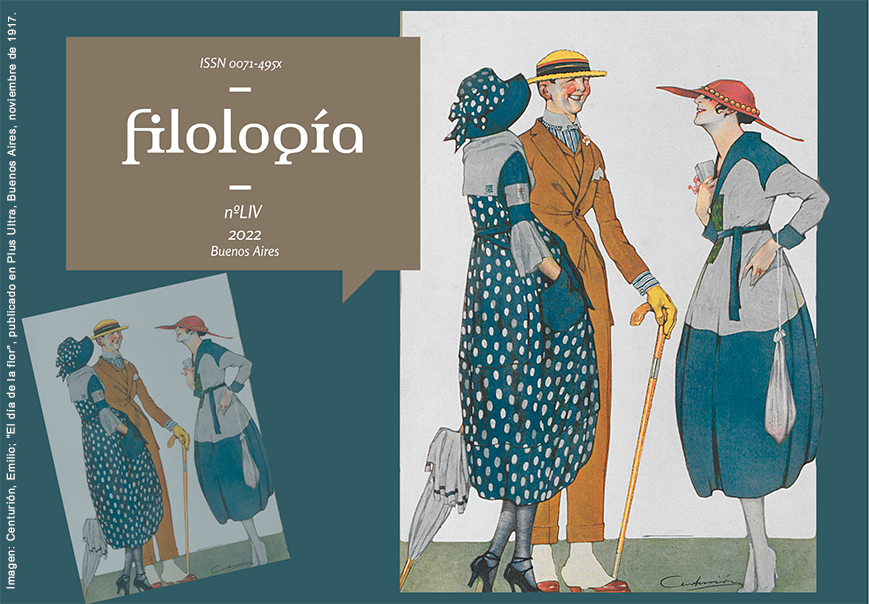Palabra femenina y discurso religioso medieval en Otas de Roma
Resumen
En el presente trabajo, se analiza el discurso de Florencia de Roma, la heroína de Otas de Roma, en relación con el de las protagonistas santas de las hagiografías previas del Ms. h-I-13 de la Biblioteca de San Lorenzo de El Escorial. Las oraciones y súplicas que jalonan el desarrollo de la historia y testimonian su avance dan cuenta de una identidad femenina que se conforma mediante la subordinación de lo terrenal a lo divino y de lo individual a lo colectivo, en consonancia con las historias de reinas acusadas a las que pertenece y con la figura política de la infanta y la problemática de la sucesión imperial.Descargas
Citas
Ashton, G. (2000). The Generation of Identity in Late Medieval Hagiography: Speaking the Saint. London/New York: Routledge.
Baird, H. L. (ed.) (1976). Análisis lingüístico y filológico de “Otas de Roma”. Madrid: Real Academia Española (Anejos del Boletín de la Real Academia Española, 33).
Baños Vallejo, F. (1994). “Plegarias de héroes y de santos. Más datos sobre la oración narrativa”. Hispanic Review, 62, 205-215.
Black, N. B. (2003). Medieval Narratives of Accused Queens. Gainesville: University Press of Florida.
Coseriu, E. (2003). “Orationis fundamenta. La plegaria como texto”. Rilce, 19, 1, 1-25.
Domínguez, C. (1998). “‘De aquel pecado que le acusaban a falsedat’. Reinas injustamente acusadas en los libros de caballerías (Ysonberta, Florençia, la santa Emperatrís y Sevilla)”. En: Beltrán, R. (ed.), Literatura de Caballerías y Orígenes de la Novela. Valencia: Universitat de València, 159-180.
Gimeno Casalduero, J. (1975). “Sobre la ‘oración narrativa’ medieval: estructura, origen y supervivencia”. En: Estructura y diseño en la literatura castellana medieval. Madrid: Porrúa, 11-29.
González, C. (1988). “Otas a la luz del folklore”. Romance Quarterly, 35, 2, 179-191.
González, J. R. (2008). Plegaria y profecía. Formas del discurso religioso en Gonzalo de Berceo. Buenos Aires: Circeto.
Hernán-Gómez Prieto, B. (2007). “El cuento muy fermoso del enperador Otas de Roma, espejo literario del código caballeresco”. En: Alonso, A. y Díez Fernández, J. I. (eds.), Analecta Malacitana. Anejos 65. “Non omnis moriar”. Estudios en memoria de Jesús Sepúlveda, 41-60.
Lea, H. C. (1986). A History of Auricular Confession and Indulgences in the Latin Church. Philadelphia: Lea Brothers & Co.
Lomax, D. (1969). “The Lateran Reforms and Spanish Literature”. Iberoromania, 1, 299-313.
Pereira Míguez, R. (2011). “La confluencia genérica en el cuento Otas de Roma del manuscrito H-I-13: en búsqueda de un género literario”. Tirant, 14, 156-182.
Ramadori, A. E. (2000). “Función de las plegarias en la narrativa española medieval”. Cuadernos del Sur, 30, 47-72.
Rodríguez Molina, J. (2008). “La confesión auricular. Origen y desarrollo histórico”. Gazeta de Antropología, 24, 1, artículo 11.
Schlauch, M. (1927). Chaucer’s Constance and Accused Queens. New York: New York University Press.
Walker, R. (1980). “From French Verse to Spanish Prose: La Chanson de Florence de Rome and El Cuento del Enperador Otas de Roma”. Medium Aevum, 49, 230-243.
Wallensköld, A. (ed.) (1907-1909). Florence de Rome. Chanson d’aventure du premier quart du XIIIe siècle. 2 vols. Paris: Librairie Firmin-Didot.
Zubillaga, C. (2008). Antología castellana de relatos medievales (Ms. Esc. h-I-13). Estudio y edición crítica de Carina Zubillaga. Buenos Aires: SECRIT.













